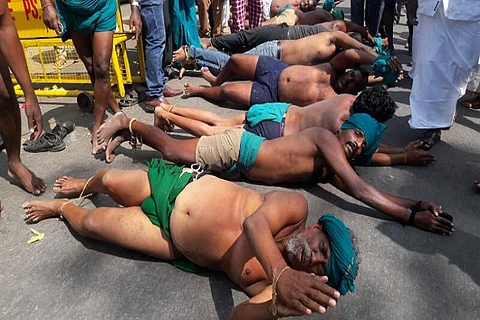

On April 1, 2017, a hundred farmers from the southern state of Tamil Nadu (TN) with half shaven heads and moustaches, rolled naked on the roads in the scorching Delhi heat. These farmers had travelled more than 3,000 kilometres from their home state of TN to Delhi, carrying with them the skulls of their fellow farmers who had committed suicide, or so they claimed. These intense and creative protests were ostensibly to attract the Prime Minister’s attention to the drought situation in TN and a consequent clamour for waiver of their agriculture loans. It didn’t work. On that day, the Prime Minister inaugurated the “Smart India Hackathon” and spoke about the “era of the Internet of Things”.
Three days later, 1.5 crore farmers of the state of Uttar Pradesh (UP) were granted a waiver of their agriculture loans, totalling Rs 36,000 crore or $5 billion by the UP government. The farmers of UP did not need to indulge in creative protests for these loan waivers. They were just rewarded for voting the Bharatiya Janata Party (BJP) into power in their recent state elections. The TN farmers are still protesting, to no avail.
Imagine, if these protesting TN farmers were also told that they are actually helping pay for the UP farmers’ loan waiver.
Salt on their wounds and scars. Not only does Tamil Nadu not help its own distraught farmers but it helps pay for farmers in UP. Farmers from Maharashtra are also protesting for waivers of their loans due to drought. Their protests have also been futile but Maharashtra is the biggest contributor to UP loan waivers. This is the saga of India’s federal taxation quagmire. To be clear, this is not about the ideology or economics of farm loan waivers but about India’s fragility as a tax union.
The Union government derives its balance sheet strength from the collective might of the various states that contribute tax revenues to the kitty of the Union government. Then, the logical next question is – which of India’s states contribute how much to this collective fiscal might of the Union government?
Four large states (Maharashtra, TN, Gujarat, and Karnataka) account for more than half of all tax collections of the Union government. On a per capita basis, the average Maharashtra resident (individual and corporate) contributes nearly Rs 33,000 per year to the Centre’s tax kitty. The average Gujarati, Kannadiga, and Tamilian contribute roughly Rs 20,000 each, per year. Contrast that with the average UPite who contributes just Rs 7,000, roughly one-third of the average Tamilian. The average Maharashtrian gives as much to the Centre’s tax kitty as the resident of five states put together – Bihar, Uttar Pradesh, Rajasthan, Bengal & Madhya Pradesh.
It is also true that the Centre gives money back to the states as devolution of resources from its pool of revenues. 42% of all tax revenue of the Centre is given back to the states and 58% is retained by the Centre for its expenses. So, each state contributes its share of taxes to the Centre and gets back a certain share. Understandably, the poorer states will get a larger share of the devolved resources while the richer states will get a smaller share.
The chart shows that the Centre gives the average Bihari Rs 30,000 every year while the average Maharashtrian gets only Rs 4800. The average UPite gets back nearly twice as much from the Centre every year as the average Tamilian.
This is an edited excerpt of Praveen Chakravarty’s ‘Noise To Signal’ column on BloombergQuint.
Read the rest of this article here